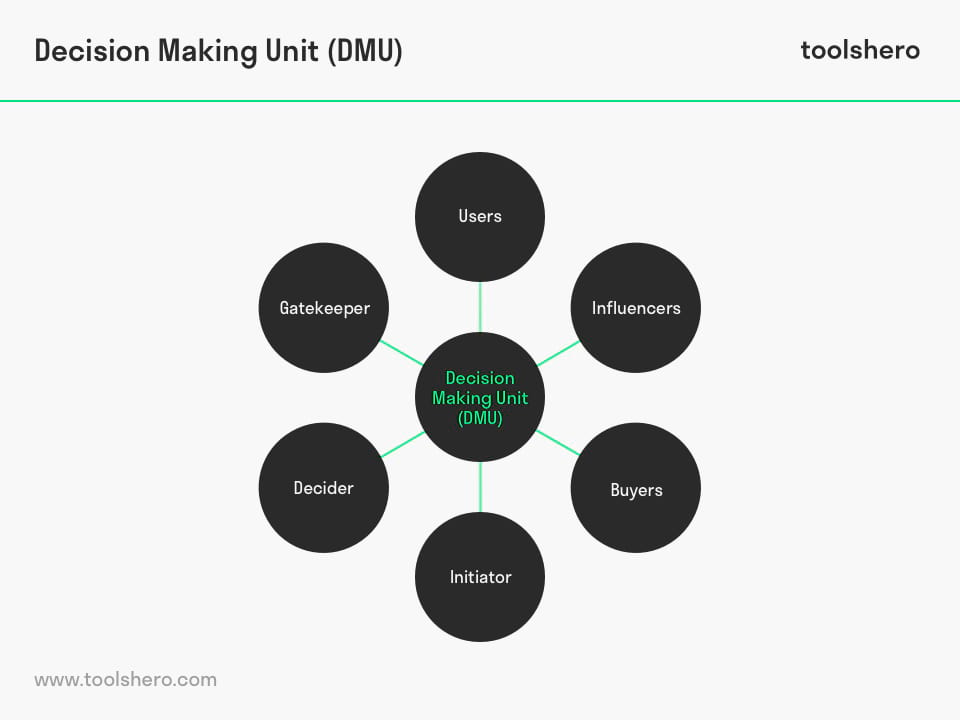DMU
Examining the Decision Making Unit (DMU) Involved in Purchase Decisions
 Graphics courtesy of Super OfficeOpens in new window
Graphics courtesy of Super OfficeOpens in new window
|
However large a company or organization, it is people who make enquiries, negotiate, place orders, and so on. Thus in organizational buying situations several people work together to reach a decision. Depending on what they need to purchase, these participants may be production workers, supervisors, engineers, secretaries, shipping clerks or financial controllers.
In a small organization, everyone may have a voice in the decision. The group of people who are involved in purchase decisions are collectively known as the decision-making unit (DMU).
Although the term may conjure up an image of offices buzzing with purchasing activity, a DMU is not a place at all. Instead, it is a cross-functional team of decision makers.
A decision-making unit (DMU) is a team of people within an organisation who play a role in the business-purchase decision-making process for products and services. It is sometimes referred to as the 'buying centre' of an organisation.
Generally, the members of a DMU (also sometimes called buying centre) have some expertise or interest in the particular decision, and as a group they are able to make the best decision.
Of course, the larger the organization the more people tend to be involved in the DMU. It is most unusual for only one person to be making decisions in the buying process. What is certain is that several people are almost always involved.
The DMU can be a formal committee but more usually is an informal group of people each with a different involvement in making a purchase. The exact make-up of a DMU cannot be predicted from one company to another. Hospitals, for example, frequently make purchase decisions through a large DMU.
When making a decision to purchase disposable oxygen masks, one or more doctors, the director of nursing and purchasing personnel may work together to determine quantities and select the best products and suppliers. A separate decision regarding the types of pharmaceutical supplies to stock might need a different group of employees to advise the purchasing manager.
The roles people take vary but will, apart from in the smallest companies, generally include a buyer or purchasing manager in charge of all the administrative aspects of purchasing.
Specialists are also likely to be involved. If equipment for the factory floor is to be bought, the production manager would be influential; if a new computer for the office is under consideration the IT manager would be important, and so on.
These managers might also choose to include in decision making those members of their department who are going to use the equipment purchased. People from the finance department will be consulted when it comes to payment or, if the sum involved is a large one, they may have to give their approval. For important purchases senior management, even the whole board of directors, might be involved.
Marketers must continually identify which employees in a firm take part in every purchase and develop relationships with them all.
 Figure X-1. Courtesy of toolsheroOpens in new window
Figure X-1. Courtesy of toolsheroOpens in new window
|
The DMU Personnel
Depending on the complexity of the purchase and the size of the DMU, a participant may assume one, several, or all of the six roles (Figure X-1).
- Initiator
The initiator begins the buying process by recognizing that the firm needs to make a purchase.
A production employee, for example, may notice that a piece of equipment is not working properly and notify a supervisor. At other times, the initiator may suggest purchasing a new product because it will improve the firm’s operations.
Depending on the initiator’s position in the organization and the type of purchase, the initiator may or may not influence the actual purchase decision. For marketers, it’s important to make sure that individuals who might initiate a purchase are aware of improved products they offer.
- User
The user is the member of the DMU who will be using the equipment, materials or services purchased.
Users can come from any level within the hierarchy and the extent of their involvement will depend on their seniority and partly on the prevailing attitude towards involving employees in the decision-making processes.
The user’s role in the decision-making unit varies. For example, an administrative assistant may give his input on the features needed in a new copier that he will be ‘chained to’ for several hours a day.
Most often, users are relatively low in status and influence but they can have a critical effect at certain stages of some industrial purchases. For example, skilled workers in a plastic molding factory may well insist that a new material is difficult to work or performs less well than existing materials. This may be enough to ensure that the material is not considered for purchase by more senior staff. Marketers need to inform users of their products’ benefits, especially if the benefits outweigh those that competitors offer.
- Gatekeeper
The gatekeeper is the person who controls the flow of information to other members.
Typically the gatekeeper is the purchasing agent who gathers information and materials from salespeople, schedules sales presentations and controls suppliers’ access to other participants in the buying process. For salespeople, developing and maintaining strong personal relationship with gatekeepers is critical to being able to offer their products to the DMU.
- Influencer
An influencer affects the purchase decisions by offering advice or supplying information for the evaluation of alternatives.
Technical staff, such as engineers, chemists or computer experts, are often cast in this role, exerting a significant influence on industrial purchase decisions through their specialist knowledge.
They can sanction a purchase proceeding and can also be sufficiently powerful to sway decision makers to their preferred choice. For more expensive purchases, the finance department will exert a similar level of influence. The influencers may or may not end up using the product. Marketers need to identify key influencers in the DMU and work to persuade them of their product’s superiority.
- Decider
The decider is the member of the DMU who makes the final decision.
This person usually has the greatest power within the decision-making unit. He or she often has power within the organization to authorize spending the company’s money. For a routine purchase, the decider may be the purchasing officer. If the purchase is complex, a manager, director or chief executive may be the decider. Quite obviously, the decider is key to a marketer’s success and deserves a lot of attention in the selling process.
- Buyer
The buyer is the person who has responsibility for executing the purchase.
Although the buyer often has a role in identifying and evaluating alternative suppliers, this person’s primary function is handling the details of the purchase. The buyer obtains competing bids, negotiates contracts and arranges delivery dates and payment plans.
Once a firm makes the purchase decision, marketers turn their attention to negotiating the details of the purchase with the buyer. Successful marketers are well aware that providing exemplary service at this stage of the purchase can be key to future sales.
| Role | Potential Players | Responsibility |
|---|---|---|
| Initiator |
|
|
| User |
|
|
| Gatekeeper |
|
|
| Influencer |
|
|
| Decider |
|
|
| Buyer |
|
|
| Figure X-2 Roles in the buying decision-making unit (DMU) – A DMU is a group of individuals brought together for the purpose of making a purchasing decision. Marketers need to understand that the members of the DMU play a variety of roles in the process. | ||
A key point to realize is that the DMU resides within the buying organization. External influences, such as the salespeople of supplying companies, are not therefore part of the DMU:
A DMU is customer not supplier based. Consequently a decision-making unit is defined as a group of people within a buying organization who are involved in the buying decision.
For very important decisions the structure of the DMU will be complex, involving numerous people within the buying organization. The marketing task is to identify and reach the key members in order to convince them of the product’s worth. Often communicating only to the purchasing officer will be insufficient, as this person may be only a minor influence on supplier choice. Relationship management is a key importance in many organizational markets.
When the problem to be solved is highly technical, suppliers may work with engineers in the buying organization in order to solve problems and secure the order. One example where this approach was highly successful involved a small company that won a large order from a major car company owing to its ability to work with the car company in solving the technical problems associated with the development of an exhaust gas recirculation valve. In this case, the small company’s policy was to work with the major company’s engineers and to keep the purchasing department out of the decision until the last possible moment, by which time it alone would be qualified to supply the part.
Often, organizational purchases are made in committees where the salesperson will not be present. The salesperson’s task is to identify a person from within the decision-making unit who is a positive advocate and champion of the supplier’s product.
This person (or ‘coach’) should be given all the information needed to win the arguments that may take place within the decision-making unit. For example, even though the advocate may be a technical person, he or she should be given the financial information that may be necessary to justify buying the most technologically superior product.
Where DMU members are inaccessible to salespeople, advertisingOpens in new window, the Internet or direct marketing tools may be used as alternatives.
The relatively low cost of direct mail or e-mail campaigns makes them tempting alternatives to personal visits or telephone calls. Setting up a website can also be relatively inexpensive once the initial set-up costs have been met. However, wrongly targeted direct mail, a poorly designed website or a badly executed e-mail campaign can cause customer annoyance and tarnish the image of the company and brand.
Business-to-business companies are turning to integrated marketing communications as a means of using the strengths of a variety of media to target business customers. Integrated marketing communications is a concept that sees companies coordinate their marketing communications tools to deliver a clear, consistent, credible and competitive message about the organization and its products.

